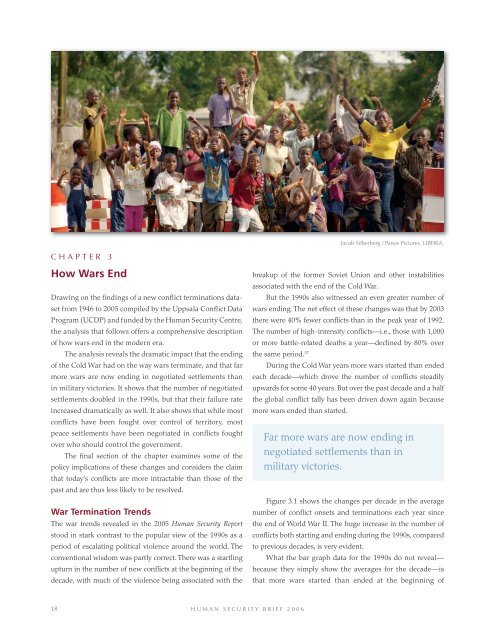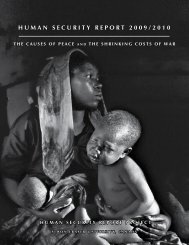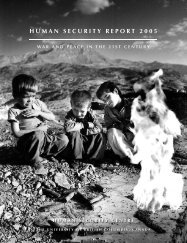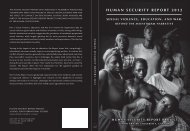Jacob Silberberg / Panos Pictures. LIBERIA.C H A P T E R 3How Wars EndDrawing on the findings of a new conflict terminations datasetfrom 1946 to 2005 compiled by the Uppsala Conflict DataProgram (UCDP) and funded by the Human Security Centre,the analysis that follows offers a comprehensive descriptionof how wars end in the modern era.The analysis reveals the dramatic impact that the endingof the Cold War had on the way wars terminate, and that farmore wars are now ending in negotiated settlements thanin military victories. It shows that the number of negotiatedsettlements doubled in the 1990s, but that their failure rateincreased dramatically as well. It also shows that while mostconflicts have been fought over control of territory, mostpeace settlements have been negotiated in conflicts foughtover who should control the government.The final section of the chapter examines some of thepolicy implications of these changes and considers the claimthat today’s conflicts are more intractable than those of thepast and are thus less likely to be resolved.War Termination TrendsThe war trends revealed in the 2005 Human Security Reportstood in stark contrast to the popular view of the 1990s as aperiod of escalating political violence around the world. Theconventional wisdom was partly correct. There was a startlingupturn in the number of new conflicts at the beginning of thedecade, with much of the violence being associated with thebreakup of the former Soviet Union and other instabilitiesassociated with the end of the Cold War.But the 1990s also witnessed an even greater number ofwars ending. The net effect of these changes was that by 2003there were 40% fewer conflicts than in the peak year of 1992.The number of high-intensity conflicts—i.e., those with 1,000or more battle-related deaths a year—declined by 80% overthe same period. 37During the Cold War years more wars started than endedeach decade—which drove the number of conflicts steadilyupwards for some 40 years. But over the past decade and a halfthe global conflict tally has been driven down again becausemore wars ended than started.Far more wars are now ending innegotiated settlements than inmilitary victories.Figure 3.1 shows the changes per decade in the averagenumber of conflict onsets and terminations each year sincethe end of World War II. The huge increase in the number ofconflicts both starting and ending during the 1990s, comparedto previous decades, is very evident.What the bar graph data for the 1990s do not reveal—because they simply show the averages for the decade—isthat more wars started than ended at the beginning of18H U M A N S E C U R I T Y B R I E F 2 0 0 6
14121086420Figure 3.1 Average Number of Armed ConflictOnsets and Terminations, per Year, 1950-2005the decade, but more ended than started during the restof the decade.OnsetsTerminations1950–59 1960–69 1970–79 1980–89 1990–99 2000–05Data source: UCDP/Human Security Centre DatasetThe end of the Cold War was associated withdramatic changes in the number of conflict episodesstarting and ending.Between 2000 and 2005 the average number of conflictsboth starting and ending each year declined sharply from theextraordinarily high rates of the 1990s. 38 More conflicts arenow ending than beginning, continuing the trend started inthe 1990s.In fact, in the first six years of the new millennium therehas been an average net decline of 1.5 conflicts each year. Ifthis rate were to continue for another 10 years, the numberof conflicts currently being fought around the world would behalved. As noted previously, however, there are many reasonswhy such a trend may not continue.Changes in war onset and termination rates have ratherobvious policy implications. A major increase in the onsetof new conflicts suggests that conflict prevention policiesare having little or no effect. A major increase in negotiatedsettlements, on the other hand, suggests that efforts bythe international community to mediate the end of wars maybe succeeding. 39Victories and Negotiated SettlementsSince the end of World War II, the manner in which wars endhas changed radically. Between 1816 and 1945 there wereextraordinarily few negotiated settlements and the overwhelmingmajority of wars were fought until one side orthe other achieved a military victory. 40 But over the past 60years mediated settlements have become far more common;the pursuit of victory much less so. By the 1990s, in a furtherradical shift, more wars were ending in negotiated settlementsthan in victories.UCDP’s new conflict termination dataset, which tracksthese changes, covers the period from 1946 to 2005. It differsfrom other termination datasets in two important ways—it isupdated annually, and it includes low-intensity conflicts inaddition to the high-intensity conflicts, which are the subjectof most other termination datasets. 41The dataset records conflict “episodes” 42 —periods of violentconflict that can be ended by military victory, or by negotiatedsettlement—a category that includes peace agreementsor ceasefires. 43 A third category, labelled “Other” in Figure 3.2,includes conflicts that end when death tolls fall below the 25battle-death-per-calendar-year threshold. 44UCDP’s data show that between 1946 and 2005, 372armed conflict episodes ended. Approximately one third ofthese terminations were military victories and just over aquarter were negotiated settlements (peace agreements andceasefires). Most of the rest either ground to a halt or simmeredalong at a very low level.Since the end of World War II, themanner in which wars end haschanged radically.But the pattern of terminations underwent major shiftsduring the period under review. The biggest changes camein the post-Cold War political turmoil of the 1990s. First, thedecade’s tally of 120 terminations (an average of 12 a year) wasmore than double the average of the previous four decades.Second, an unprecedented 35% of all conflicts ended in someform of negotiated settlement.During the Cold War decades victories had outnumberednegotiated settlements by more than two to one. But in the1990s the reverse was true—42 conflicts ended in negotiatedsettlements; just 23 in victories. Between 2000 and 2005 therewas a further change: there were four times as many negotiatedsettlements (17) as there were victories (4).This increase in negotiated settlements since the endof the Cold War has been associated with a major upsurgein international activism directed towards stopping armedconflicts.As the 2005 Human Security Report pointed out, theUN’s peacemaking efforts increased enormously between1990 and 1999, with similar increases in activity by regionalH U M A N S E C U R I T Y B R I E F 2 0 0 6 19






